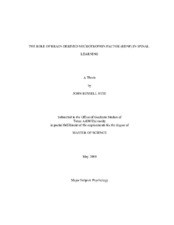| dc.description.abstract | Previous research in our laboratory has shown that the spinal cord is capable of a
simple form of instrumental learning. Spinally transected rats that receive controllable
shock to an extended hindlimb exhibit a progressive increase in flexion duration that
reduces net shock exposure. Subjects that receive uncontrollable shock, on the other
hand, do not exhibit an increase in flexion duration, and are unable to produce this
instrumental response even when they are later tested with controllable shock. This
behavioral deficit can also be elicited by intermittent shock to the tail, and as little as 6
minutes of this shock is sufficient to produce a deficit that can last up to 48 hours as
shown by Crown, Ferguson, Joynes, and Grau in 2002.
Instrumental training has been shown to provide a number of beneficial effects.
The instrumental training regimen produces a lasting effect that enables learning when
subjects are later tested with a more difficult response criterion. Similarly, instrumental
training can provide protection against the deleterious effects of uncontrollable shock as
shown by Crown and Grau in 2001. The present study aims to determine the role of brain-derived neurotrophin factor (BDNF) in the beneficial effects of instrumental
training.
Experiments 1 and 2 examined the role of BDNF in the facilitory effect of
instrumental training. Through the inhibition of endogenous BDNF, Experiment 1
showed that BDNF is necessary for the facilitation effect. Experiment 2 demonstrated
that exogenous BDNF can produce the facilitation effect in dose-dependent fashion.
Experiment 3 showed that the inhibition of BDNF attenuates the protective effect
of instrumental training. Likewise, Experiment 4 showed that exogenous BDNF can
substitute for instrumental training, and produce this protective effect. Experiment 5
showed that exogenous BDNF can block the development of the deficit when given
immediately after uncontrollable shock. Experiment 6 showed that exogenous BDNF
can block the expression of the deficit.
Taken together, these experiments outline a major role for BDNF in mediating
the beneficial effects of instrumental learning in the rat spinal cord. | en |


